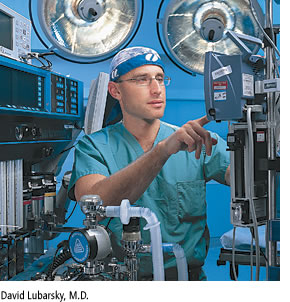 One of the top priorities at University of Miami Hospital is patient safety, and nothing short of making it the safest hospital in the world will satisfy David Lubarsky, M.D., M.B.A., Emanuel M. Papper Professor and chairman of the Department of Anesthesiology, Perioperative Medicine, and Pain Management. One of the top priorities at University of Miami Hospital is patient safety, and nothing short of making it the safest hospital in the world will satisfy David Lubarsky, M.D., M.B.A., Emanuel M. Papper Professor and chairman of the Department of Anesthesiology, Perioperative Medicine, and Pain Management.
In his role as senior associate dean for quality, safety, and risk prevention, Lubarsky is charged with making sure the best systems are in place to make the hospital as safe as it can be. “Safety is everything, from making sure there’s not too much wax on the floor so patients don’t slip, to ensuring doctors wash their hands every time they see a patient,” explains Lubarsky.
The Miller School already participates in national safety initiatives, but Lubarsky says rather than just participating “we want to lead the way in first proving what initiatives work and then being at the forefront of implementation.”
The number one priority of all the initiatives: infection prevention. Each year 200,000 patients in the United States develop an infection in the hospital and 90,000 die; that’s roughly 250 patients dying per day from a preventable cause. UM is at the forefront of this fight.
“The UM-JMH Center for Patient Safety has produced a widely disseminated soap opera-like video through a government grant to demonstrate the hazards of poor hand hygiene and is actively involved in a variety of research regarding what works best in getting physicians to always wash their hands,” says Lubarsky. “It sounds so simple, we know we should be doing it, but it’s still not being done.”
A previous study at the center examined where soap dispensers should be placed around patient rooms in order to maximize hand washing. A recently awarded $400,000 grant from the federal government will fund research on how to build and renovate safer hospitals.
“We will specifically be looking at how to create an automatic reminder system for hand washing using electronic chips embedded in ID cards that will be able to record when someone has used the sink or an alcohol-based, hand rub dispenser,” says David Birnbach, M.D., M.P.H., director of the UM-JMH Center for Patient Safety and chief patient safety officer for UM. According to Lubarsky, “UM Hospital will likely be the first place in the world where such advanced ideas and systems are rolled out.”
Another key area is eliminating medication mistakes, which harm more patients than almost anything else. Poor handwriting, typos, look-alike and sound-alike drugs, all have been blamed, but as Lubarsky says, “In the end it’s all about the systems.”
“You need to have a systematic approach—in this case, a single computer system for drug entry, and patients need to be involved and ask their doctor, ‘Are you sure that’s my medication?’” says Lubarsky. “It’s not enough to be a good doctor, we need to enhance our capabilities through better systems. UM Hospital is shopping now for an enterprise-wide electronic medical record system that would include a state-of-the-art drug order system. It’s about combining high technology and slow, plodding, methodical step-by-step attention to detail—stuff we already know, but don’t always do, and that’s how you create the safest hospital in the world.” |


